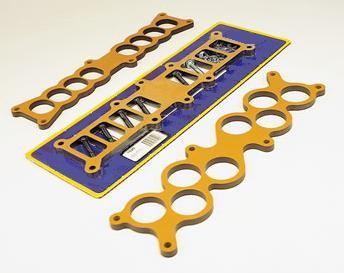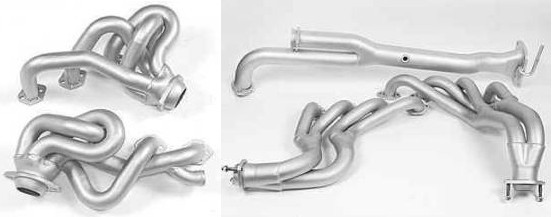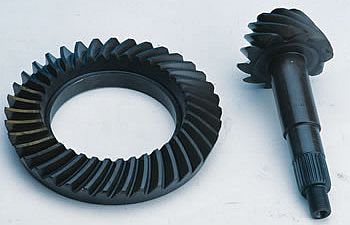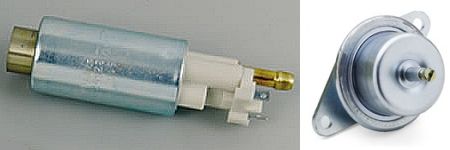EFI Performance Upgrades

This page covers the basic relationship between engine performance modifications and fuel injection. There are more performance pages that talk about:
Ford Computer Performance Upgrades
How 2 Install a Chip in a Ford computer
Aftermarket EFI Computers
Let's start with a short list of stuff not to do, just to keep you from thinking about hurting your Ford. The following list contains ideas that are usually bad, unless you have a larger game plan and know what you're doing.
•Thermostat changes under 180°
This only tricks your EEC and hurts your engine; leave this trick for the drag strip.
•Altering ECT or ACT
This only tricks your EEC and hurts your engine.
•Unhooking EGR
The computer turns off the EGR during wide open throttle anyway.
Make sure the sensors give CLOSED signals to the computer when removed.
Fuel ratios and timing will be miscalculated by the computer if done incorrectly.
•Changing fuel pressure
This is something only needed for real big plans
40PSI can make 500 rear wheel horse power
•Changing MAF
This will only confuse your computer, no performance gain in its self.
Read about MAF in the sensors section.
•Changing Injector size or adding injectors
This will only make your fuel ratio unpredictable
Read about injector in the actuators section.
Sorry for ruining some of your plans but if you keep reading you'll learn now to make plans for power gains. Let's cover the basics quickly, engines are just large air pumps, and the more air and fuel they can pump the more power they make. You need to keep the air velocity characteristics of each engine part matched. Air velocity is the engines peak potential for air flow. This potential determines where the RPM power band is. Air + Fuel + Spark = Power, more of each at just the right times makes more power. The stock EFI computer has the fuel and spark timing calculated real well so you’ll have to start with some basic engine work to make you engine require more air and fuel. You can't just slap on a high tech aftermarket EFI system and expect any gains in power. Most vehicles however are born in the factory with some horsepower hidden inside. I am no engine builder nor can I guaranty power gains for certain combinations; I am just reciting common knowledge.
Camshafts

Camshafts are an important selection with EFI, pick the wrong cam and your computer be unhappy. Contrary to popular belief, a bigger cam will not necessarily make more power; in fact it can sometimes cost you performance. Stock cams actually have a very efficient profile and shouldn’t be your first engine upgrade. Larger cams might make a little more power but will generally shift the power band of an engine upwards. If your vehicle has stock heads, intake, or both, installing a larger cam is a waste of time and money. On the other hand, if you’ve got a good matched set of high flow cylinder heads and intake, a cam change can be worth the effort.
Large cams that change the engines manifold vacuum will confuse a Speed Density EFI system which will improperly calculate engine load. Large cams that cause a surging or pulsing of air at idle will confuse a Mass Air Flow EFI system, making idle quality suffer. If you still feel the need keep the lobe separation of the cam at or above 114 degrees. Be cautious with lift over 0.5"; any more might create an interference if the timing chain brakes.
A cam swap might need larger fuel injectors! The computer is programmed with the stock cam profile, so it knows how much time it can hold an injector open. If your cam opens & closes the valves faster; small injectors might not have enough time to deliver all the fuel. A larger injector will deliver fuel faster. Changing the cam and injectors will benefit from EFI programming of some type.
Intake Manifolds
Intake manifold changes are pretty straightforward. Fuel injection now gives us the ability to move the point where the fuel is introduced into the air stream as close to the cylinder head as possible and aim it for better fuel atomization. Fuel injection also gives us more flexibility in routing the intake runners.
•Long skinny intake runners create air velocity and torque at low RPM.
•Short fat intake runners create air velocity and horsepower at high RPM.
However long skinny intakes don't make high RPM horsepower. Short fat intakes don't make low RPM torque. You need to match all your engine parts for full potential. Also match your engine to your vehicles weight. Heavy trucks and daily drivers need low RPM torque. Lighter race cars can utilize high RPM horsepower. The Ford GT-40 and Edelbrock Performer intakes are probably the best for maximum torque at lower RPM. It’s to hard to recommend an intake for maximum high RPM horsepower, there seems to be a new intake each year.
 Heat spacers are another trick you can use to fine tune the length of your intake runners. Longer runners are better for low-end torque. Don't forget to include larger throttle bodies, MAF sensors, and a low-restriction air filter in your plans to improve breathing. Keep the MAF calibrated to your stock injectors!
Heat spacers are another trick you can use to fine tune the length of your intake runners. Longer runners are better for low-end torque. Don't forget to include larger throttle bodies, MAF sensors, and a low-restriction air filter in your plans to improve breathing. Keep the MAF calibrated to your stock injectors!
Cylinder Heads

“More air and fuel in, more power out.” That's what good cylinder heads can do. They allow the engine to breathe more efficiently, which in turn makes more power. The potential of any engine is limited by its cylinder heads. You can try to push more air and fuel into an engine with a blower or nitrous, but the amount you force in is still limited by the efficiency of the cylinder heads. Bigger is not always better when cylinder heads are involved. Port shape and configuration are much more important than size, first match them to your intake. A port that is too big on a relatively mild engine can actually make the car run slower than stock. You have to think about more than just size, a larger port does not always flow more air, shape is everything. Check airflow numbers and calculate what your engine needs. As with everything else, the right combination of pieces will make the most power, not just buying the best numbers out of a catalog.
Supercharging / Turbocharging

This one needs little explanation, pump in air, and you have more power. This won't work on Speed Density EEC's, you’ll need to reprogram it or upgrade to MAF. Things to look out for are heat, if pressure melts ice during a hockey game; pressure also increases intake air temp and engine temp. Rising air temperature will decrease its density. You remember density right? Cooler air is denser air, engines burn pounds of air not cubic feet. Big pressures will require spark retarding and more fuel. The more you boost, the more you will need EFI programming.
Nitrous
Nitrous Oxide is by far the biggest bang for the buck. Fact, you can make no performance modification for the same amount of money that will yield the performance gains of nitrous. Since Nitrous is only used at Wide Open Throttle it does not affect street-ability or gas mileage when it’s not being used. Unless you open the bottle you have no effects of nitrous. Nitrous systems for EFI systems are a simple plate that mounts between the intakes. Expanding nitrous cools the intake air charge by 60° – 75° F, which is alone worth horsepower.  When a system is installed properly and jetted / tuned to a level the engine is comfortable with, there are no adverse effects to Nitrous Oxide use. Nitrous systems have their own fuel supply; this means most EFI systems need no additional tuning to operate with nitrous. For sprays greater than 100HP you will need a strong engine and retard the ignition timing by 4-8 degrees (1 to 1-1/2 degrees timing retard per 50 HP gain.) There are some new nitrous systems that add nitrous as load increases, this may need EEC tuning at the very least and possibly a new engine management control system other than EEC. If you need a power builder on a small budget, spray it.
When a system is installed properly and jetted / tuned to a level the engine is comfortable with, there are no adverse effects to Nitrous Oxide use. Nitrous systems have their own fuel supply; this means most EFI systems need no additional tuning to operate with nitrous. For sprays greater than 100HP you will need a strong engine and retard the ignition timing by 4-8 degrees (1 to 1-1/2 degrees timing retard per 50 HP gain.) There are some new nitrous systems that add nitrous as load increases, this may need EEC tuning at the very least and possibly a new engine management control system other than EEC. If you need a power builder on a small budget, spray it.
Increased Displacement
"There's no replacement for displacement." But you can't change the displacement without effecting the computer.
•Speed Density fuel injection will become lean if you increase the displacement without re-programming. It can not adjust to that much extra air volume.
•Mass Air fuel injection will become rich if you increase the displacement without re-programming. It will sense the extra air volume, but assume you are forcing it into the smaller engine.
Ignition / Spark Controllers
This is a touchy subject; everyone thinks they need one and that they will get big gains from it. NOT true, why do you need one? Really, do you have a reason to buy one? Let me explain why you might not need to spend the money. A well-tuned, normal compression street engine has no need for a spark controller. A poorly tuned engine will burn cleaner and get a little help, but if you tuned it properly first you would get a better response. If you're running higher compression, adding boost or nitrous then a spark controller could be warranted. Higher pressures and higher octane make it more difficult for a spark plug to ignite. It's like lighting a match in a wind storm. Multiple, longer, and stronger sparks are now needed.
One thing you can do for added performance is easy and free. You can adjust the base timing a little further than 10°BTDC. Try 12, if that works without detonation, try a little more. The more you add, higher octane fuels might be needed. Just keep your ear open for detonation, or else you'll be buying new pistons. Understand that adding more timing to the base line will add that much timing to every part of the program.
Exhaust

This is also a simple one, larger diameter flows more. Mandrel bends and free flow mufflers have fewer restrictions. Air velocity can play a role in exhaust. Smaller exhaust does add a nominal amount of low RPM torque. But it's typically not enough to worry about over exhausting your engine. Look at you frame rails, firewall, drive shafts, and where you want the exhaust to go. Equal length shorty style headers typically don't increase power enough to warrant the head ache to change spark plugs. You can buy exhaust with provisions for O2 sensors or weld in O2 sensor "bungs" into the exhaust. Try your absolute hardest to place the O2 sensors back in the stock position in relation to the cylinder head. But be careful that they don't hit the firewall or make it too hard to replace them. Don't underestimate your local exhaust shop, but make sure they're VERY clear on what you want.
Gears and Tires

This has all been covered before. Just make sure you match you power band range. If your power range is idle-4000, try to make your final drive run on the highway at 2200RPM with overdrive. Like wise if your power range is 3000-7000 with a well-built engine, final drive on the highway should be about 2800 with overdrive. But the higher your power range and drive ratio. you’ll be shifting more and losing street-ability. Higher gears always give you that funny back of the seat acceleration feeling, and open differentials just spin one tire.
Fuel System

The fuel system should only be upgraded when your engine is being starved for fuel. The stock fuel delivery system can provide enough fuel for 350horse engines. You can get a better fuel pump, add a fuel pump, or increase the voltage to the stock fuel pump. Sometimes all you need is larger fuel lines to feed the engine. All are very acceptable and have proven results. Make sure you're providing more fuel than your engine burns, set up a gauge off the test port and run it full throttle a few times, make sure the pressure stays constant. More power means more flow. I've seen engines make well over 500RWHP with only 40PSI, so you typically need more volume not pressure. The injectors can always be upgraded to provide more fuel, the higher the injector rating the more amps it requires to operate it. A stock EEC can't more than 2 amps per injector, and stock 19lb injectors draw 0.75 amps. Currently 50lb injectors are the limit; keep this in mind when buying larger injectors. You want to stay away from low impedance injectors with a stock computer.
I ended with fuel system upgrades for a reason; you can pump as much fuel into the injectors as you want. But the computer controls the injectors, so any time you want to increase the amount of fuel injected into your engine you need to control the computer. Fuel pressure and injector upgrades always require the EEC to be reprogrammed for peak results.
Aftermarket EFI Computers
